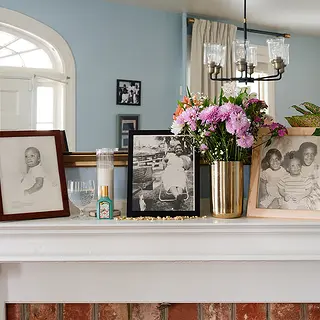
Literary Giant Lucille Clifton's Home Now Serves as a Hub of Creative Expression
The house never really left her thoughts. From the distance of 40 years and nearly 3,000 miles, 2605 Talbot Road in Baltimore—Sidney Clifton’s childhood home—stood firm in her memory. “The house is never far, I don’t think, in any of my siblings’ hearts,” she says.
Built in the early 1900s, the three-story, wood-frame house felt friendly, magical, and generous. A playmate, in and of itself.
“The wraparound porch? Amazing. It was an additional room. It was a playroom. It was a stage. It was a roller-skating rink. You could practice riding your bike,” she enumerates. “Also, all of us could play easily, in a protected manner. Mom and Dad didn’t have to have to look too far to see us, and it was so, so inviting, so the porch is a big deal.” So, too, were the old-fashioned iron-gate elevator and the multiple levels that allowed the six Clifton siblings to have the run of the upper floors with raucous games of “chase” and infinite adventures of imagination.
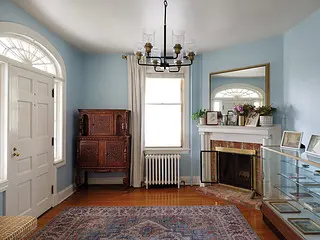
photo by: Jennifer Hughes
In The Clifton House's welcoming entry area, family photos top the original mantelpiece.
In the late 1960s Sidney’s parents—sculptor, community activist, and educational consultant Fred Clifton and on-the-rise poet Lucille Clifton—were still living in Buffalo, New York. They were in search of an ample place to make a home with their six children. “Multiple people were showing my dad different houses and different places where they thought that a Black family with this many children should be living. And my dad, being who he was, started doing some investigation of his own,” she recalls.
That trek led him in 1967 to Baltimore’s Windsor Hills, which was likely “not a neighborhood that that circle of advisers knew about,” says Sidney. “I think an ‘intentionally integrated’ neighborhood is what it was called back then. He saw the house and said, ‘This is it.’”
Sidney suspects that there wasn’t one specific feature that drew her father to the house. Rather, it was a feeling that settled in him. “I believe he walked up on the porch and looked out toward the horizon—the parks, the trees—and saw the future. Honestly. I think he deeply saw the future in that house.”
He was right. For a time.
What he could not have imagined was what lay waiting, just out of view, down time’s road. Braving a patch of unexpected financial commitments and setbacks, the family would lose their enchanted sanctuary to foreclosure in 1980. A heartbreak that still feels sharp, unjust, and fresh to Sidney, many decades later. “I remember my mother being quoted as saying, ‘I don’t think my family ever got over losing their house.’”
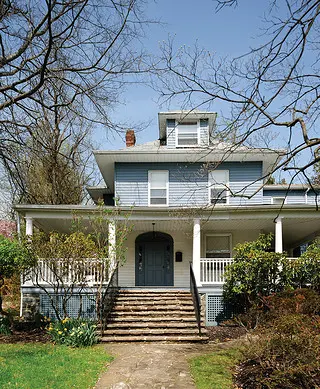
photo by: Jennifer Hughes
The Clifton House's sizable front porch.
But that terrible rupture would not be the end of the Cliftons’ connection to 2605 Talbot.
In 2019 Sidney Clifton repurchased her former family home. The opportunity: a gift of chance, timing, and nimbleness. The steps leading back to the house—and its current evolution—could not have been predicted. She took a risk and trusted the leap: “I bought it sight unseen.”
Over the past few years she’s been working with great focus to convert the property into a nonprofit space—The Clifton House—providing mentorship, training, support, and development to practitioners of the creative arts, often from historically marginalized communities.
She describes The Clifton House, in this incarnation, as a “sanctuary for emerging poets, writers, artists, and creatives,” because that was what the house had provided for her family. Growing up with two creative parents, she and her siblings observed all that went into making a writer’s or an artist’s life. Creating wasn’t simply staring down an empty page or contemplating the grain in a piece of wood; their parents modeled the commitment to both community and their practice. It was as much about looking inward as it was about looking outward.
Sidney wanted to re-create that feeling and intention while encouraging emerging artists and writers, both in person and virtually, through classes, workshops, residencies, and exhibitions. The nonprofit would offer assistance not just with craft, which is essential, she says, but also with the business end of creating a sound foundation and durable net of support.
Helping to fortify this dream, The Clifton House received a preservation and planning grant in 2020 through the National Trust for Historic Preservation’s African American Cultural Heritage Action Fund (AACHAF), which awards funding to assist, protect, and restore sites that represent American history through the lens of Black history.
The striking plot twist of re-acquiring the keys to their
family home has given Sidney and her siblings a deeply longed-for sense of
peace.
Stay connected with us via email. Sign up today.
Brought together by art, Fred Clifton and Lucille Sayles met as actors in Buffalo’s community theater world in the late 1950s, introduced by the writer Ishmael Reed. They would marry in 1958 and would begin to grow their family.
Years later, the impetus of the Clifton family’s move to Baltimore was to allow Fred to establish the federal Job Corps program there. He later worked as an educational consultant for organizations such as the United States Department of Education, the World Bank, and UNESCO. Lucille had worked in various state and federal government jobs and became writer in residence at Coppin State College (now Coppin State University) in Baltimore.
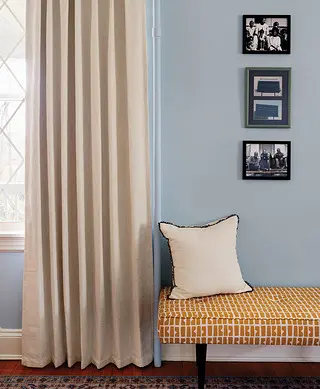
photo by: Jennifer Hughes
The Clifton family's re-creation (bottom) of an old photo taken by Rollie McKenna on the front steps (top) led to Sidney Clifton's repurchase of the house.
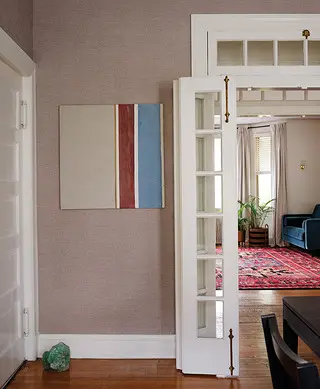
photo by: Jennifer Hughes
Preserved original details include transom windows and folding French doors. The sand-and-acrylic painting is by Fred Clifton.
The generous space of Talbot Road gave them room to pursue their full selves—their work, their art, and their focus on raising and nurturing a family.
Sidney remembers her father’s dedicated community engagement and his commitment to his garden, tending plants and flowers. She remembers her mother, in intermittent pools of quiet, at work at the dining room table. “I have very, very clear images of her silhouette, with the light coming through the windows, and her writing on a manual typewriter. I’d hear the ‘ding’ when she’d get to the end of the line. I remember seeing her scratching out the words she wanted to change, and then writing, in longhand, the new words.”
Lucille Clifton completed her first collection of poems, Good Times (published in 1969 by Random House), on Talbot Road. More books of poetry and a memoir, plus an appointment as Poet Laureate of Maryland, followed during those years. They were, as a family, in a flow.
No amount of foreshadowing could have prepared Sidney for what was in store for her family in the late 1970s. What she remembers of that time—culminating with the foreclosure in 1980—comes back in pieces.
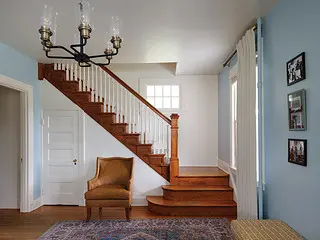
photo by: Jennifer Hughes
The front staircase at The Clifton House. The floors have been refurbished to match the way they looked when the Cliftons lived there.
“Leading up to the experience things were very uncertain. There were cuts in my dad’s salary and my mom was working sporadically,” she says. “Sometimes, the relationships with couples who are high-functioning and doing lots of things—frankly, the communication suffers.” In her parents’ case, “that 100 percent contributed.”
More than anything, she remembers with bitter clarity the day of the house’s auction: “[We were] inside the house, looking out. The auctioneer was on the front porch. And we had neighbors coming up to bid.
“I remember feeling so betrayed,” she recalls. “There’s almost like an out-of-body piece of it—where I was traumatized and anxious and trying not to cry. To be strong for my mom. But also remembering the auctioneer’s [voice], and that moment thinking, ‘Wow, they really do talk really fast.’ I had to do both those things.”
All these years later, she pauses, carefully sorts her words. “Even talking about it now, I feel it in my body.”
Separated along gender lines, the family settled into two different locations. Eventually they reconvened in a rental in Columbia, Maryland, and then moved to Dickeyville, on the western edge of Baltimore. Life went forward, then sideways, then forward again. Sidney’s father died in 1984; her mother, in 2010, after a luminous career that included a National Book Award and two Pulitzer Prize nominations. Over that time Sidney would lose two siblings; she would move to California to pursue a career in the entertainment industry. But the presence of the house stayed within her and her remaining sisters and brother.
“I have very, very clear images of her silhouette, with the light coming through the windows, and her writing on a manual typewriter. I’d hear the ‘ding’ when she’d get to the end of the line.”
Sidney Clifton
Over the years, even after her move to Los Angeles, Sidney kept in touch with the house. Like a far-off pen pal, “I always tracked it.”
By chance, one day in 2018 when she was back in Baltimore, she decided to contact the current owner to find out if she might be able to walk onto the property to re-create a favorite photo of her and her siblings sitting on the front steps. The owner mentioned that she was getting the house ready to sell, but Sidney says she “thought nothing of it at the time.” This reconnection set a series of events in motion.
In the midst of her busy life in Los Angeles, she says, “I woke up with this deep instinct to reach out to [the owner] to see what’s happening with the house. I emailed her, and she emailed me back, in, like, what seemed like 15 minutes. She said that the house just went on the market [that day].” It was February 13, 2019, the anniversary of Lucille Clifton’s death. In parting, the owner added: “It would be nice to have a Clifton back in this house.”
Sidney quickly dialed her sister Gillian, announcing, “Gill, this is gonna sound crazy, but Talbot Road went on sale today. I’m going to try to buy it.” How, and with what reserves, would be puzzles to solve along the way.
“I had no reason to believe that this is something I could pull off,” she says. But she was drawn toward a filament of possibility. “I felt that there was no reason for me to have gotten this message and have this instinct if this wasn’t possible, right? So I jumped through many hoops.”
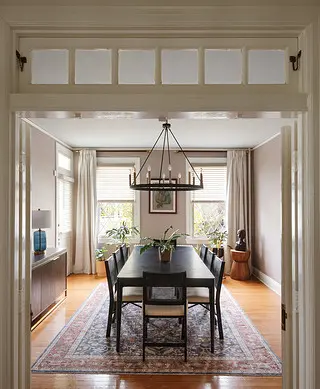
photo by: Jennifer Hughes
A sculpture by Fred Clifton is visible in a corner of the dining room.
The Cliftons hadn’t been beyond those front stairs in more than 40 years. Even Sidney, who had conducted all of the purchasing business from L.A., hadn’t had a moment to travel back to Baltimore until it was time to sign closing papers.
Returning to Talbot Road, now as owner, she remembers approaching the back of the house with two of her siblings. “Our usual way to enter,” she explains. “I was so nervous. Walking up those stairs and putting the key in. My hands were shaking.” Crossing the threshold, she announced into the echoey rooms, “Hi, Ma! Hi, Dad!” just as she always had. A muscle memory. She keenly felt her parents there.
Wandering through the rooms, touching the walls, and exploring the nooks where she and her siblings read, played, dreamed, the memories rushed back. It was only natural, she told herself, to check to see if the house still held them, too. “When I was 11 or 12, I’d written my name in cursive in a cedar closet. It was there. There’s a chimney on the back porch where my sister Fredrica had written ‘Clifton 2605 Talbot.’ It’s still there. Also, some abstract art my dad did in spray paint on the wall in the basement? Still there. It’s like the house had been waiting for us.”
Her father had been right. He had indeed seen a future there for his family. Now, it was their duty to shape it. After all the trauma, guilt, and pain of losing the house, there was a chance to make a correction—not simply to cross out the past, but to insert a new way forward.
Not only had the house been waiting for them, says Sidney, but it was already telling her what it was supposed to be. She hadn’t been back in California for three weeks before a familiar feeling settled over her. “It’s the same way I woke up to reach out to the former owner.” There it was, a complete vision in her head: “This place is The Clifton House because this is where Mom and Dad had sanctuary for emerging artists and writers. It’s a place where we’re going to train up folks, give them opportunities to hone their craft, but also teach them about the business of their craft. So that no one has to feel like my mom did,” she explains. “Leaving this place feeling like they didn’t do enough. Feeling that they are disappointing people. We are going to show them the business of their art.”
When the idea sparked, so fully formed, she knew the path was right. After she established the nonprofit, “the vision never wavered.”
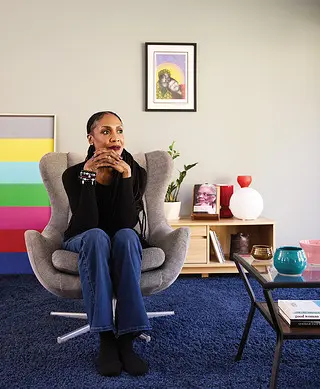
photo by: Joe Schmelzer
Emmy-nominated film and television producer Sidney Clifton at home in California, with a photo of her parents and a few of her mother's books.
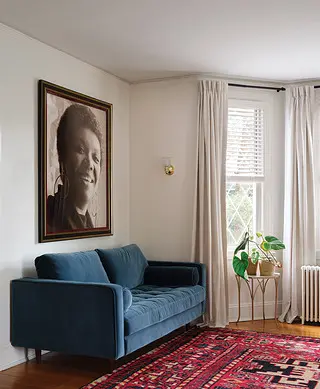
photo by: Jennifer Hughes
A photo of Lucille Clifton in The Clifton House's living room.
Her first move was to incorporate and then take steps toward obtaining nonprofit status and, eventually, funding. The AACHAF grant was one of the first grants she applied for. “It gave us the momentum we needed,” she says. Concurrently, she worked her various networks, canvassing and brainstorming. “I contacted people—the surrounding neighbors, spoke to my sisters, started reaching out to people who loved my mom’s work.”
As it turned out, some of the reverse also happened. Poets and others who were enamored by her mother’s work reached out to her. Like Janelle Hughes, a former journalist who had remade herself into an interior designer. Hughes knew of Lucille Clifton’s legacy and stumbled onto Sidney’s passion project online. “I’d started following Sidney on social media and saw her interest in revamping the space,” says Hughes. “I cold-emailed her expressing interest and curiosity: ‘What are your goals?’ That was kind of the start of it.” They set up a call and Hughes told Sidney about her then-Baltimore-based design firm, co-owned at the time with designer Kim R. Williams. “I said, ‘If you ever need interior design support, I would love to work on this project.’” The three women ended up inking a deal.
Each room, each passageway, informed Sidney and the designers of what they needed to be: “[Much of the space] is tied to its original purpose,” she explains. “The living room, where people gathered, that’s where we have gatherings now, where we have readings. The dining room, where my mom wrote, tends to be where we hold workshops. The second floor has the Lucille Clifton Suite, which will [host] resident artists and writers in what used to be ‘Mommy and Daddy’s’ room.” The house’s first public event, held in March 2024, featured award-winning writers Aaliyah Bilal and Safiya Sinclair in conversation. Other programs over the past year have included a six-week poetry workshop and a ceramics workshop for children.
Working on the larger rehabilitation project meant confronting changes the latter owners had made to the house’s floor plan. The designers restored most of the original footprint. They were sensitive to the need to merge the original early 1900s feel with what it would have been like to inhabit the space in the late 1960s and ’70s. For example, they used checkerboard flooring in the kitchen to meet both goals. “We really wanted to honor and execute Sidney’s vision,” says Hughes.
“It's a place where we're going to train up folks, give them opportunities to hone their craft, but also teach them about the business of their craft.”
Sidney Clifton
Most key, adds Hughes, was balance: Coaxing out a sense of the family’s presence and imprint while honoring a just-out-of-reach memory of what the house might have looked and felt like when Fred Clifton first set eyes on it. “So I think, honestly, it was really about understanding and conveying the essence of who these people are.”
Says Kim R. Williams, who has continued to work with Sidney on more recent and ongoing design projects at the house, “You can feel the echoes of the past of stories shared, creativity nurtured, and family life unfolding. And yet, the design welcomes the future. It’s a place for gathering, storytelling, and inspiration, just as it always was.”
As with any old house, there is always something to address. The balcony needs strengthening; the yard needs reimagining to include outdoor reading and sitting space and a community garden. Sidney sees the old garage as future studio space.
It’s been exhilarating for her to experience the house populated by a new generation of creatives—the sound of words being read aloud, the tumble of laughter over meals, the buzzy quiet that comes with hard, focused work.
Sidney visits 2605 Talbot about once a quarter. She doesn’t stay overnight at the house but often works onsite during the day. Her father’s azaleas still grow in the garden, and some of her mother’s awards rest in locked cases. “Every time I enter, it is, ‘Hi, Ma. Hi, Dad.’ I feel so good to be able to give her—this house—what she needs. To represent my family and give the community that place to grow,” she reflects. It’s a fresh piece of paper loaded into the typewriter. A new chapter to be written. Finally, an exhale: “I feel like we won.”
Donate Today to Help Save the Places Where Our History Happened.
Donate to the National Trust for Historic Preservation today and you'll help preserve places that tell our stories, reflect our culture, and shape our shared American experience.


